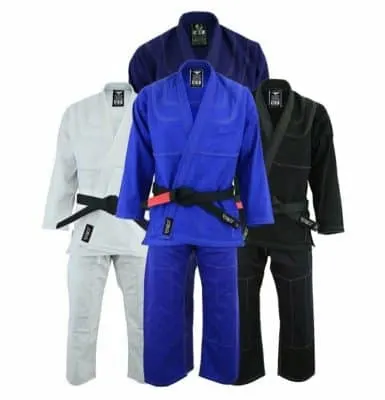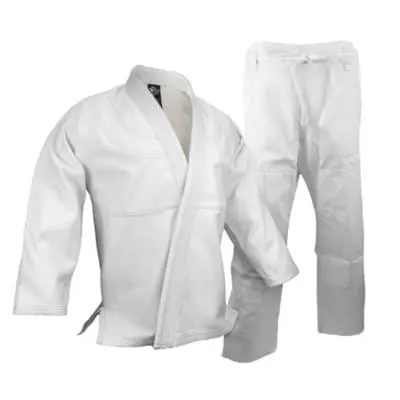
Most martial arts have a grading system or a hierarchical system where colors of belts and gi have significance and denote progress in the martial art. Different martial arts place different significance on the colors of gi and belts, so knowing what you should choose for your gi can be a little confusing. If you are looking to study Brazilian Jiujitsu or BJJ, you may be interested in finding out if there is significance to gi colors in this martial art.
BJJ does not put any significance on the color of the gi used for training, but the most commonly accepted colors are white blue, and black. If you will be training other martial arts other than BJJ, then a white gi would be the best choice because it is the most accepted across all disciplines.
When looking into the correct gi colors for a martial art, it is important to not only know what rules the martial art prescribes but also what the dress code is at your local training facilities. Sometimes the training facility imposes their own dress code on students, which you need to be aware of before you go out shopping for your gi.
What Do BJJ Gi Colors Mean
Although there is no ranking associated with the color of the gi used in BJJ, there are some formalities to the color of gi if you intend to compete or attend seminars. The International BJJ Federation only recognizes the use of a gi in white, blue, or black for the purposes of competition.
The color of the gi in BJJ holds no significance as to the level of progression in the martial art. The traditional color of the gi is white but blue or black are also acceptable to practice the art. The color of the gi is likely to be dictated by the dress code required by your training facility.
Before you go ahead and buy your gi for training BJJ, check with your local training facility as to what they allow for training at their venue. The colors that are most commonly used are white, blue, or black. The colors that are generally used for beginners are white or blue.
Why Are Gi White?
For most martial arts, there is an emphasis placed on tradition, formality, and discipline. These principles are displayed throughout the practice of the martial art as well as in mental attitude and in the dress code. So why is the traditional color of the gi white?
White is the color of purity, cleanliness, and simplicity, which are all key foundational characteristics in many martial arts. The white color also levels the playing field where students cannot have inflated egos since everyone is the same. The only designation of progression is the belt.
Having a white gi also required the discipline of washing a gi properly after training to ensure that the gi was white once again for the next training session.
Many martial arts take the white colors to the belts as well. In a martial art such as Aikido, you are a white belt until you become a black belt. Even though there is a grading system, you will continue to wear a white belt until you gain the black belt qualification, and at this point, you are allowed to distinguish yourself from other students by wearing a black belt and a black hakama.
Does Gi Color Matter In BJJ?
The color of the gi has no significance in BJJ with regards to rank or etiquette. However, there are some formalities about the colors that are preferred when practicing BJJ.
The color of the gi does not matter in BJJ, but the color is often dictated by the training facility where you will be training. The most commonly accepted colors are white, blue, and black. If you intend to compete or attend seminars, then your gi needs to be one of these colors.
The mixing of colors of gi is not allowed, so, for example, you cannot wear a blue top with white trousers. The top of the gi and bottom of the gi needs to be of the same color.
What Gi Color Should I Choose As A Beginner?
As a beginner in a martial art, you want to portray an attitude of humility and not stand out from the crowd. Wearing a different color gi to everyone else may be seen as being egotistical and that you consider yourself better than your fellow students.
The safest color to choose for a gi as a beginner in a martial art, including BJJ, is white since this is the most widely accepted color for a martial arts training uniform. Some training facilities implement their own rules for gi colors, so check with your school before buying a gi.

Most schools allow you to attend the first few classes without a gi. At these introductory classes, you can check what color gi the other students wear and buy appropriately.
What Do You Wear Under Your Gi?
Traditionally, the gi was underwear that the trainee stripped down to for training. In the modern setting, you need to wear appropriate clothing under your gi.
You need to wear sports underwear under your gi pants. A man can wear nothing under his gi top, or he can wear a training shirt. Women should train with a sports bra and a training shirt under their gi top since the gi often comes loose during a vigorous training session.
Many people opt for wearing compression pants, often known as cycling or fight pants under their gi pants which offer coverage should your gi pants fail.
How Many Gi Should I Own?
There is no correct number for the amount of training gi that you should own. The main consideration is that you show up to each training session in a clean gi.
You can get by with owning 1 gi if you can get it washed and dried before your next training session. The requirement is to have a clean, fresh gi for each training. Many people who train more frequently find it convenient to have 2 or 3 gi that they rotate in and out of the laundry.
If you train up to 5 times a week, two gi uniforms may not be enough, but a maximum of 3 should more than suffice to rotate for your training.
Can I Wear A Black Gi As A White Belt?
Some people may consider the wearing of a black gi as presumptuous if you are a white belt, but there is no rule within BJJ that prevents you from wearing a black gi if you have a white belt.

You can wear a black gi as a white belt. In a BJJ class, you will be judged by your attitude rather than the color of your gi. In some training facilities, it may not be allowed for you to train with a black gi, so check with your school before getting a black gi.
The acceptable gi colors for most training facilities are white, blue, or black, irrespective of what color the belt is that you have achieved.
Is It Disrespectful To Wear A Black Gi?
Some beginners to martial arts may wonder if the wearing of a black gi is disrespectful. The answer depends largely on the martial art and on the school where you train. Generally, for BJJ training, a black gi is acceptable.
It is not considered disrespectful to wear a black gi, even as a beginner, if your training school allows the wearing of a black gi. What is considered disrespectful is wearing a gi that is not clean. If your school allows the wearing of a black gi, then go ahead and wear one if you want.
Some martial arts disciplines are very traditional and require that their students wear a white gi only, but most modern schools are not as traditional and will allow a gi of other colors.
Can I Use A BJJ Gi For Judo?
The gi used in Judo is often made from a heavier duty material because the discipline requires the throwing of the opponent, often by holding onto the gi.
If your BJJ gi is white or blue and does not have a lot of patches or branding on it, then it will most likely be acceptable to use for Judo. A black gi for practicing Judo would generally be considered unacceptable. It would be wise to check the acceptable colors with the school beforehand.
Judo normally adheres to the more traditional, conservative ways of the traditional arts, but some schools may be a little flexible in this regard. It is always best to check with the training facility to establish the correct protocols regarding gi colors.
How Do I Choose A BJJ Gi?
Most gi manufacturers use a sizing chart that gives the size rated on a scale of A0 to A5, where the A stands for adult, and the associated number relates to your height. The cut of the gi is usually designated by L for long, S for short, and H for heavy. Here are some tips for choosing your BJJ Gi.
For color, you should stick to a gi that is white, blue, or black. The basic size chart is as follows:
- A0 for under 5’4’’ in height
- A1 from 5’4’’ to 5’8’’
- A2 from 5’8’’ to 5’9”
- A3 from 5’9” to 6’2”
- A4 from 6’2” to 6’6”
- A5 over 6’6”
Choose between short, long, or heavy, relative to your build.
As a beginner in BJJ, it would be best to start with a gi that is as clean and free from branding and patches as possible until you know what is acceptable at your training school.
